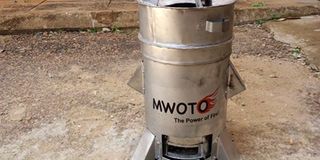HOW IT WORKS: Mwoto cookstove

Cook stoves are the most common way of cooking and heating food in developing countries like Uganda. It is estimated that up to 50 per cent of the energy that is consumed in the developing world goes into cooking food.
Whether in the rural or urban areas, wood or charcoal is the main fuel that is used. Subsequently, there is deforestation and soil erosion because of cutting down trees for firewood or to make charcoal.
In addition, there are health implications of using traditional methods of cooking such as the “three-stone method”—where a cooking pot or saucepan is placed on three stones of the same height to balance it over a fire—or the charcoal stove, sigiri, which is commonly used in urban areas.
Cooking this way brings a lot of smoke, which causes particularly lung and eye ailments and also birth defects as well as scalds and burns from open fire. The air pollution, according to the World Health Organisation, is responsible for the death of 1.6 million people every year.
Besides the health problems, with the three stones or sigiri, fuel is wasted, as heat is allowed to escape into the open air. Also, the money a family spends on wood or charcoal translates into less spent on other needs. Thus, research has been undertaken to improve cookstoves for efficient cooking methods.
There are now various types of improved cookstoves. One of these is the Mwoto cookstove, which was developed by Centre for Research in Energy and Energy Conservation (CREEC), Makerere University. It is a top-lit updraft micro-gasifier with high energy and high efficiency capabilities that uses wood bits, coffee and rice husks, dry maize cobs and briquettes as fuel.
This means that when the biomass (plant and animal material, especially agricultural waste products, used as a source of fuel), is burned, the various gases and vapour produced in the smoke is driven from the fuel and then burned to produce the heat to cook.
It is based on what scientists have known for long—that burning of biomass is cleaner when the air is well mixed with only combustible gases, instead of having the combustion occur where solid fuel is present. The creation of these combustible gases separate from the combustion of those gases is a distinguishing characteristic of a gasifier.
Besides creating gases and separating the burning process from it, Mwoto cookstove is top-lit, meaning that the fuel is lit from the top unlike in a sigiri where the fuel is lit from the bottom.
It works on the updraft principle, where air is injected from the bottom and the fuel enters at the top and moves down under the force of gravity. The high energy efficiency of this type of cookstove is due to the efficient counter current heat exchange between the rising gases and descending biomass.
The Mwoto cook stove works on the updraft principle: As the primary air is elevated upwards through the fuel, it is burnt by heated secondary air emerging from the concentric tube, the eventual gaseous mixture burns steadily like a gas stove.
The parts
The pot holder, where the cooking pot sits. It contains the concentrator and riser responsible for the updraft. Outside cover, the lower visible part of the stove upon which the handles and legs are installed to make it firm on any surface.
Removable fuel chamber, the inner cylindrical component where the fuel is loaded. It is removable and placed concentric (with a common axis or centre line) to the outer chamber.
The air control base, which holds the removable fuel chamber and controls the burning process as it regulates the amount of primary air entering into the fuel chamber.
Heating the fuel in the removable fuel chamber generates smoke, which is promoted by natural draft of primary air, the smoke is mixed with oxygen-rich secondary air and “flamed” above the removable fuel chamber in the complete combustion zone.
The biomass is lit on top, where pyrolysis—heating of organic material at high temperatures without the use of oxygen—starts to generate smoke. The unburned biomass is gradually consumed towards the bottom, leaving charcoal behind in the charcoal zone.
The benefits
Faster cooking: The high firepower enables the cookstove to excel in boiling, steaming, deep and shallow frying. Produce charcoal: It can be run with a variety of non-wood (maize cobs and briquettes) and waste wood fuels (twigs and wood off-cuts), which significantly reduces time spent collecting fuels.
Consumes less fuel: Its low consumption enables households using the cookstove to spend less on cooking fuel; their incomes is reallocated to other essentials like food, health care and education.
Emits less smoke: It emits less smoke compared to any other biomass stove technology, thus reducing indoor air pollution and greenhouse gas emissions.
Environmentally friendly: the stove has a reduced net addition of carbondioxide in the atmosphere; its unique carbon neutral process reduces deforestation and encourages the use of waste biomass in the long run.
Conserves energy: With a thermal efficiency of 45 per cent over the nine per cent for a wood stove, it conserves a 50-60 per cent cooking energy. Laboratory and pilot studies that proved Mwoto cookstove as the most economical and powerful biomass cookstove in Uganda.




